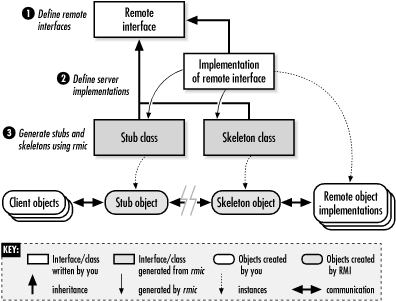Defining Remote Objects
Now that you have a basic idea of how Java RMI works, we can explore the details of creating and using distributed objects with RMI in more detail. As mentioned earlier, defining a remote RMI object involves specifying a remote interface for the object, then providing a class that implements this interface. The remote interface and implementation class are then used by RMI to generate a client stub and server skeleton for your remote object. The communication between local objects and remote objects is handled using these client stubs and server skeletons. The relationships among stubs, skeletons, and the objects that use them are shown in Figure 3-2.

Figure 3-2. Relationships among remote object, stub, and skeleton classes
When a client gets a reference to a remote object (details on how this reference is obtained come later) and then calls methods on this object reference, there needs to be a way for the method request to get transmitted back to the actual object on the remote server and for the results of the method call to get transmitted back to the client. This is what the generated stub and skeleton classes are for. They act as the communication link between the client and your exported remote object, making it seem to the client that the object actually exists within its Java VM.
The RMI compiler (rmic) automatically generates these stub and ...
Get Java Enterprise in a Nutshell, Second Edition now with the O’Reilly learning platform.
O’Reilly members experience books, live events, courses curated by job role, and more from O’Reilly and nearly 200 top publishers.

